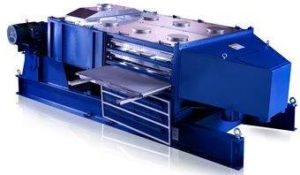Screening
 Classification or gradation of particle size can be achieved by mechanically screening the material. Utilizing a unique gyrating reciprocating screening action, the screening unit can provide accurate separations at high production rates. Near size separations benefit from a ball cleaning action underneath the screen deck. The horizontal action keeps the material on the screen surface maximizing the possibility of the particle finding the screen opening or passing over the screen because it is oversized. Having multiple screen decks in one machine allow for multiple screen cuts. This screen technology can be used over scores of industries handling hundreds of different materials.
Classification or gradation of particle size can be achieved by mechanically screening the material. Utilizing a unique gyrating reciprocating screening action, the screening unit can provide accurate separations at high production rates. Near size separations benefit from a ball cleaning action underneath the screen deck. The horizontal action keeps the material on the screen surface maximizing the possibility of the particle finding the screen opening or passing over the screen because it is oversized. Having multiple screen decks in one machine allow for multiple screen cuts. This screen technology can be used over scores of industries handling hundreds of different materials.
Scalping
Scalping is the process of removing oversize material from a vast majority of good product. Typically these scalped material represents less than 5% of the product flow. With the gyratory reciprocating action, the flow rates through a scalping deck can be substantial allowing the screening surface to be minimal relative to a typical gradation application. Scalping applications are typically used to receive raw materials before the process and as safety screeners before a product is shipped to an end-user.
Fines Removal
Fines removal is typically removing a small amount of fines from the main product material. As with scalping, this normally represents a small amount of material in the product flow. Using the gyratory reciprocating action, the product typically stratifies, with the fine material segregating to the bottom of the material flow, hence the fines are right on top of the screen clothing. Fines removal typically helps clean the material before packaging or processing.
Air classifier
Mechanical classification is common but so is air classification. The particle shape and size, and density plays a more important role in using an air classifier as a means of classifying material. An air classifier can you stationary blades in a mechanical classifier or use a whizzer to make an air classification. Typically the overs will discharge out of the classifier in the fines will get captured in a secondary filter.